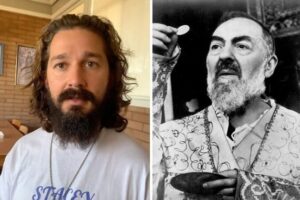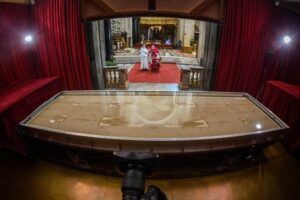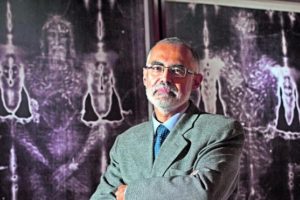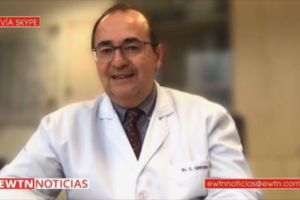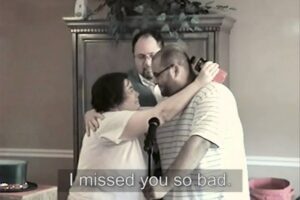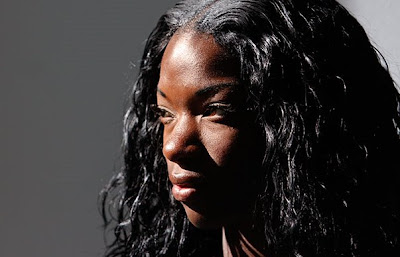Young mother tells the story behind baby born alive and left to die at Florida clinic
The mother of a baby ‘born alive’ and hidden on the roof of a Hialeah clinic tells her side of the story.
MIAMI | On the morning of July 20, 2006, Sycloria Williams, age 18, went for an abortion – a late-term abortion that she says went terribly wrong.
Now 21, the Hollywood resident has filed a civil lawsuit accusing the clinic staff of delivering her child alive and killing the newborn girl by stuffing her into a biohazard bag.
Williams spoke exclusively to the Florida Catholic Jan. 28. She said she is sharing her experience of what happened inside A GYN. of Hialeah Inc. because people “need to know.”
A slight woman with dark, almond-shaped eyes, black hair and a bright smile, Williams said her friends call her “Slim” because of her build and propensity to stay that way. Her favorite food is coconut shrimp.
Williams named her dead daughter Shanice Denise Osbourne, after her then-boyfriend, who accompanied her to the abortion clinic. “Shane looked over me,” she said.
The baby’s biological father had left after she told him she was pregnant. “He just stopped calling, coming around,” Williams said. “He just disappeared, you know.”
Originally, aborting the baby was not part of the plan. “We were reluctant at first, but as time passed it became more and more of an option,” Williams said.
She had had a prior pregnancy at 17 that had ended in a miscarriage. She said she was unaware of how far along she was because she was not showing. “My belly still looked pretty flat.”
ABORTION: DAY ONE
According to Williams and the allegations in the lawsuit, she found the clinic in the Yellow Pages. On July 17, 2006, she went to Miramar Woman Center Inc. and was told the procedure would cost $1,200 – $400 more than she expected, because a sonogram had determined that the pregnancy was 23 weeks along, requiring a more complicated late-term abortion.
Williams said that day she signed consent forms and was given some medications, all without meeting her doctor, Pierre Jean-Jacque Renelique.
She met him two days later, July 19, at A Woman’s Care Inc. in North Miami. Williams said Renelique gave her a brief, undetailed description of the procedure.
“He said that it was a two-day procedure, to take my medicines, and come back the next day. He just said it like one, two, three,” Williams said.
She said she asked questions about the abortion and felt Renelique’s answers were to her satisfaction.
“I asked a lot of questions. I asked like how long it would take, who would be my doctor, how often have they done this, about the equipment, and what they do with the baby,” she said.
“They said they freeze the body,” she added. “They freeze it,” she repeated in a whisper, lowering her head and eyes.
After their meeting, according to Williams, Renelique inserted laminaria sticks, thin rods of dried kelp that absorb moisture and slowly dilate the cervix. According to the lawsuit, he also gave her a prescription for Cytotec, a brand of the drug misoprostol, to induce labor.
“He just to told me to come back the next day and that he would be there,” Williams said.
Shortly after leaving, Williams said she received a call from Natali Vergara, the daughter of clinic owner Belkis Gonzalez, telling her to go to their Hialeah clinic, A GYN., instead of the North Miami one to complete the procedure.
ABORTION: DAY TWO
On the way to the clinic the next morning, her boyfriend at the time, Shane, “didn’t want to go through with it,” Williams recalled. She just wanted to put it all behind her. “I was thinking ‘Come on. I want to get this done!’” she said.
When she arrived at the Hialeah clinic, she remembers having to knock on the glass doors because they were locked. “They weren’t open yet.”
The receptionist, a woman identified as Rosemary Chaneton in the lawsuit, let her in. Williams remembered that the clinic had white walls, tiled flooring and inset fluorescent lights.
She said Chaneton gave her two white pills to take. “She didn’t know what the pills were but said she would ask. She said they would make me feel sick,” Williams said. According to the lawsuit, the white pills were another dose of Cytotec, to induce labor.
She took the pills and waited in her car. “I wanted to wait in the car because I was feeling a little sick already and Shane was there.”
She waited in the car for Renelique to arrive. About 45 minutes after taking the two white pills, Williams said she felt sick with nausea and felt the baby dropping “… like something was pushing it down.”
She went inside the clinic and exchanged her white T-shirt, blue jeans and flip-flops for a white hospital gown with little blue dots and “the back out.” She was then taken to a patient waiting room in the back. Shane was prohibited from entering. The waiting room had eight reclining chairs, with the same white walls, inset lights and tiled floor.
“The chairs looked comfortable,” Williams said. She sat in the one closest to the door of the waiting room.
“I was alone in that room for about three hours with Rosemary (the receptionist) and other people checking up on me every couple minutes,” Williams said.
As the Cytotec continued to work, Williams felt sicker and sicker. “I was nauseated and I had a temperature,” she said.
Although she was relatively calm, she was worried that Renelique had not arrived. “‘Where is the doctor?’ I was thinking.”
Williams remembers feeling worse as her labor intensified. She was curled up in a ball with the receptionist by her side. “I was supposed to be asleep for all of this. I wasn’t supposed to see anything. Just wake up and it will all be over,” Williams said.
LIVE BIRTH CAUSES PANIC
What happened next haunts her to this day, Williams said. “It was like everything inside was coming out at once.”
Williams recalls grabbing the armrests of her chair and elevating herself to a squatting position, heels at the edges of her seat. The receptionist and staff kept telling her to sit down and close her legs, but she couldn’t comply. “There was just no stopping it,” she said.
Williams said she delivered her baby, Shanice, onto the recliner almost immediately after squatting. First amniotic fluid spilled out, then the baby dropped onto the cushion.
“When I saw that happen, I jumped off the chair and turned away, facing the wall,” Williams said.
Shanice’s body slid on the blood and amniotic fluids into the rear corner of the recliner because she was still attached to Williams by the umbilical cord. “When I jumped off I pulled her like into the back of the chair because she was still attached,” she said.
According to Williams and the lawsuit, the receptionist and the staff began screaming and rushing, trying to figure out what to do. Williams said she stood against the wall, glancing in horror at her newborn baby. “She wasn’t moving much. Twitching, gasping for air. She wasn’t crying though, just hissing. Hissing sounds only.”
The sight of a fully formed baby was a complete surprise to Williams.
“I thought it would be a blob thing, but bigger, not a baby,” she said. “She looked like a Water Baby. Like those dolls you fill up with water. She was really little, like this,” she said, holding her hands about 12 inches apart.
(Water Babies are sold in stores such as Toys ”R” Us. A product description on the Toys ”R” Us online store reads, “Water Babies are water-filled dolls that replicate the warmth, weight and feel of a real baby.”)
According to the lawsuit and Williams’ recollection, Gonzalez, the clinic’s owner, who has no health care licensing, came into the waiting room, cut the umbilical cord, and scooped Shanice’s body into a red biohazard bag, sealed it and tossed it into a trash can.
Williams said she was in shock. “It felt like a dream,” she said.
She recalls begging God for help and trying to listen to the staff. They only gave her Motrin for her pain because Renelique had not yet arrived. “Everyone was panicking,” Williams said.
According to the lawsuit, the doctor arrived about 60 minutes after Williams delivered Shanice. No one called an ambulance. The lawsuit also states that Rene
lique gave Williams a shot to put her to sleep: “She awoke after the procedure and was sent home still in complete shock.”
She said while Shane was driving her home, she told him, “I don’t think that baby was dead.” Answering almost as if he did not hear correctly, Shane asked, “What do you mean? Are you sure?”
He asked several more questions which Williams said frustrated her because she was preoccupied with what happened to her at the clinic. “I was just focused on trying to deal with it. I was scared,” she said.
POLICE FIND BODY
The next day, Hialeah homicide detectives, tipped off by an anonymous caller, arrived at her residence. “Oh, I know why you’re here,” she said she told them. She said she spent four hours that night at the police station, and returned the following morning to file more reports and make more statements to investigators.
According to the lawsuit, Hialeah police investigators executed a search warrant at the clinic on July 22, 2006. They found medical records but could not locate the baby’s remains. Six days later, another anonymous caller told police the baby’s body had been hidden on the roof. Police responded but found nothing. After a third tip and another search warrant, the police found the baby’s decomposing body in a cardboard box in a closet at the clinic. DNA linked the remains to Williams.
Williams said in the immediate aftermath of the abortion, she did not have much time to digest what had happened. “I was very busy with everything.”
She does recall the most startling part: Her 23-week-old pregnancy looked like an actual baby.
“They never said anything to me that would make me think it was a baby. They never said anything like baby, fetus. Nothing. They only said things like ‘termination’ and ‘pregnancy’ and ‘termination of pregnancy,’” she said. “They cheated me because they didn’t tell me everything and the doctor wasn’t there.”
She said the staff’s reaction to the live birth made her feel disrespected. “They tried to make it look like this was my fault. Like I asked for this. … They wouldn’t admit to me the whole time something went wrong,” she said. “I feel like they treated me like nothing, like a nobody.”
She said she has not sought professional counseling. “They’ll listen because that’s their job, but they won’t care. They won’t understand,” Williams said.
She said she and other post-abortive women need love, support and family. She also has changed her mind about abortion.
“No one should lose their life if you get pregnant,” she said. “If I got pregnant again I would have the baby.”
Her advice to women in unplanned or crisis pregnancies is to make abortion their last option, if at all. “I would tell them not to do it. I’ll say whatever to make them have second thoughts so they don’t do it,” she said. “There is help out there.”
ABOUT THE CASE
Sycloria Williams is being represented by the Thomas More Society, with Miami attorney Tom Pennekamp handling the case. She is suing for wrongful death, medical negligence and personal injury. The lawsuit alleges that Belkis Gonzalez and 12 other defendants – who jointly own or work for a conglomerate of four south Florida abortion clinics – engaged in an unlicensed and unauthorized medical practice, botched abortions, evasive tactics, falsified medical records and killing, hiding and disposing of a baby who was born alive.
Williams finally buried her daughter, Shanice Denise Osbourne, last November at Our Lady Queen of Heaven Cemetery in Fort Lauderdale. The Miami-Dade County Medical Examiner had held onto the body for nearly two years, concluding that the child was born alive, but would have died anyway due to extreme prematurity. The state attorney’s office says the matter is still “under investigation.”
The Florida Catholic tried unsuccessfully to contact the clinic owner and others named in the lawsuit. Pennekamp said he has not been able to find all the defendants in order to serve them with copies of the lawsuit.
A GYN. of Hialeah Inc., where the abortion took place, has closed down, but the court filing alleges it has been replaced by a new clinic a few miles away that “shares the name of the previously mentioned corporation, only lacking a period after GYN.” A Miramar Woman Center Inc. and A Woman’s Care Inc. in North Miami remain open.
Belkis Gonzalez and Siomara Senises, both defendants in this lawsuit as co-owners of A GYN. in Hialeah, were arrested for the unlicensed practice of medicine in connection with a 2004 case in another Miramar clinic co-owned by the pair, according to newspaper articles and public records obtained by Williams’ attorney. That clinic was shut down in 2005. Two doctors who performed abortions at that clinic were found to be unlicensed; one was found guilty of practicing “abortion medicine” without a license and the other fled to Trinidad and has arrest warrants pending in Miami-Dade and Broward count
ies. Gonzalez pleaded “no contest” in that case and was adjudicated “guilty” and sentenced to five years probation Dec. 20, 2007. Under the terms of her probation agreement, she is not allowed to directly or indirectly own, operate, conduct, manage or be employed or associated with any health care clinic, business or establishment.
On Feb. 16, 2007, the Florida Department of Health filed an order of “emergency restriction” against Dr. Pierre Jean-Jacque Renelique’s medical license because of the events that occurred at the Hialeah abortion clinic in July 2006. He is accused of medical malpractice and falsifying medical records and is awaiting “a formal restriction or discipline of the license” by the department.
At a hearing Feb. 6, 2009, the Florida Department of Health revoked Dr. Pierre Jean–Jacque Renelique’s medical license — meaning he will not be able to practice medicine in Florida — because of the events that occurred at the Hialeah abortion clinic in July 2006. He was found to have violated Florida statutes by committing medical malpractice, delegating responsibility to unlicensed personnel and failing to keep an accurate medical record.


